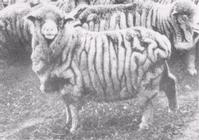


Chapter 1
I Groping In A Strange Environment: 1788-1851
II Farmers Take The Initiative: 1851-1888
III Enter Education And Science: 1888-1927
IV Agricultural Science Pays Dividends: 1927-1987
V Examples Of Research And Development 1928-1988
i Land assessment
ii Improving the environment
iii Adapting to the environment
iv Improving farm management
VI International Aspects Of Agricultural Research
VII Future Prospects
VIII Acknowledgements
References
Index
Search
Help
Contact us

By the middle of the 19th century sheep-raising had spread well into the inland, where breeders were developing distinctive Merino strains. Parts of Victoria, Tasmania and the Tablelands areas of NSW remained with Spanish or Saxon types, growing so-called 'fine-wool' strains; in the lower rainfall areas 'medium-wool' strains were developed. These were larger animals with wool of slightly higher average fibre diameter, produced by judicious slight introduction of British long-wool breeds, followed by selection. The most popular strain for many years was known as Peppin, after the brothers who developed it in the Riverina area of NSW in the nineteenth century. In South Australia an even greater infusion of British breeds led to the large-framed longer-stabled South Australian 'strong-wool' strains. Subjective selection by Australian breeders made great achievements, producing Merino strains with distinctly different characteristics, but with steadily increasing greasy fleece weights; in NSW, for example, the average greasy fleece weight per head for sheep and lambs rose from about 2.5 kg in the 1870s to just under 4 kg in 1930.


The rate of increase in fleece weight, however, slackened, and from 1930 to 1950 there was very little change. In the early 1950s scientists in CSIRO and State Departments of Agriculture (led by Drs. Helen Newton Turner, E H. W. Morley and R. B. Dun) started to apply new techniques of animal breeding to the Australian Merino.[83] These techniques depended on first determining what characteristics were required by the end consumers of wool, then investigating how they could best be measured, to what extent they were inherited, to what extent different characteristics were correlated and how they could be combined for selection.
The first step was a conference of research and extension officers, held in Brisbane in 1951, at which the value of introducing objective measurements into selection procedures was stressed. This was followed by a Fleece Measurement Conference in Sydney in 1954, the establishment of measuring laboratories in various States and an intensive campaign by extension officers to encourage the inclusion of measurement instead of relying entirely on eye and hand when selecting breeding stock.
The importance of objective measurement was stressed by pointing out that, although traditional methods had made remarkable achievements and had led tomarked increases in average fleece weight per head, the rate of increase had slowed virtually to zero between 1930 and 1950.
Measurement, then, was important, but what measurements? Fleece weight per animal is simple to obtain, and it was soon shown that visual selection for high fleece weight was only 40 per cent as efficient as using scales. But should it be greasy weight, as it leaves the sheep (i.e. clean wool plus grease plus dirt), or the amount of clean wool, which is what the processor wants? Fortunately it was found that the two are highly correlated, and therefore scientists suggested preliminary selection on greasy weight, reserving clean weight (obtained by scouring a sample) for top rams.
Organisations in Australian Science at Work - CSIRO
People in Bright Sparcs - Dun, Dr R. B.; Morley, Dr F. H. W.; Turner, Dr Helen Newton
 |
Australian Academy of Technological Sciences and Engineering |  |
© 1988 Print Edition pages 49 - 50, Online Edition 2000
Published by Australian Science and Technology Heritage Centre, using the Web Academic Resource Publisher
http://www.austehc.unimelb.edu.au/tia/053.html